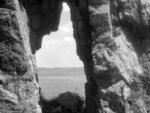Stuart McHardy introduces the idea of geomythography, with an example of the insights to which this process may lead.
Geomythography is a process of analysing landscape and society over time through evidence from oral tradition, archaeology, place-names, ritual and belief and the landscape itself.
Significantly shaped hills – ‘paps’ – in various parts of Scotland and elsewhere have been the focus of ritual and belief for millennia and in this vein the first ‘Mythogram’ – an analysis with visuals in film form – was broadcast at the Netherbow Theatre in Edinburgh on 3rd March 2016 as part of a Storytellers on Film event. Here I would like to address one of the seminal finds that led to the development of this process.
For many years a group of us have been going out to the island of Scarba, off Argyle opposite Kilmartin, to investigate the Corryvreckan whirlpool, which has several ancient tales associated with it that are clearly mythical in nature. In the course of research into Scarba and Jura (the island on the southern side of the whirlpool), I kept being drawn back to a folktale collected in the 1880s – Mac Iain Direach.1

The natural stone arch on Scarba
In this story the hero is obliged to go on a quest that involves, amongst other motifs, a Sword of Light, a shape-shifting fox and the Seven Big Women of Jura. Now, after decades of investigation of folk tales, myths and legends about Nine Maidens from around the world, I had always thought that this was the origin of the tale of the Seven Big Women; and that their links to one of the Paps of Jura also echoes the relationship with the goddess figures that feature in so many Nine Maidens traditions.2 The goddess here would be the Cailleach, who is at the core of the tales about the Corryvreckan whirlpool, still talked of within living memory as ‘the breath of the goddess under the waves’.
However, after many re-readings of the tale one thing jumped out at me . The hero is said to have landed on Jura at a spot called Creag nan Deargan – the Rock of the Little Red One. Deargan can refer to a type of fly and a type of fish, but there is another potential interpretation. I noticed that Creag nan Deargan was actually on Scarba, not Jura, and resolved to go there, intrigued by the fact that on the OS Pathfinder map there was also a cave called Uamh nan Deargan.
On first approaching the cave I was intrigued by the fact that you get to it from the N through a natural stone arch. The cave itself shows all the signs of occupation from at least Neolithic times, a fact confirmed by the Hebridean archaeologist Ian McHardy (not a direct relation), who accompanied me on a later visit. The cave, which stretches back about 15ft, is formed directly in a fault line that runs across Scarba and the rock on the N side is red-tinged.

The simulcrum of a human head on the ceiling of Uamh nan Deargan cave, Scarba
What was most exciting, though, was a shape in the roof. Formed in the natural rock – with no signs of tooling, and also not a stalactite – this shape is like a human skull, the size of a baby’s head. Its position in the cleft of the roof, upside down, is also redolent of an actual birth. The occupants of this cave could not have avoided seeing this.
So the question must be asked. Is this Cave of the Little Red One named after the skull? After all, children do arrive in the world covered in blood; and with the redness of the rock, might we also speculate as to the possibility of this having been a birthing cave?
Another intriguing question is why did the folk tale mislocate Creag nan Deargan – was this a mistake or a deliberate ploy to draw attention to this fascinating place?
Notes
- Campbell, J.F. Popular Tales of the Western Highlands Birlinn (1994 Repr) Vol 2, p. 90-115.
- McHardy, S.A. The Quest for the Nine Maidens, Luath Press 2003.
Published in NE145, June 2016, pp.16-17